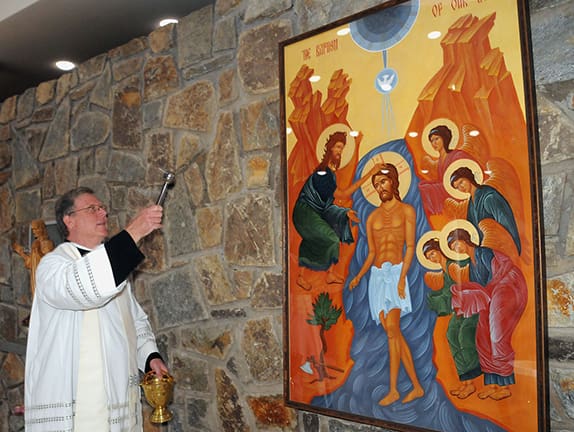Online Edition
January 2015
Vol. XX, No.7
Prayer in Paint: New Icon to Instruct, Inspire

by Katie Scott
Saint Michael Church, Annandale, Virginia
Bold blues, deep greens, and delicate, precise lines drew parishioners’ eyes to the new icon inside St. Michael Church in Annandale. With Christ at the center, His head encircled by a golden halo, “The Baptism of Our Lord” is the fruit of an ancient tradition given fresh life.
Father Jerry J. Pokorsky, St. Michael pastor, commissioned iconographer Veronica Royal to create the piece earlier this year, and he blessed it at the end of the noon Mass September 28.
The blessing was held the day before the parish’s feast day and coincided with the annual parish picnic.
“Father Pokorsky wanted a traditional icon; he wanted something that if people stood in front of it, they could understand it and be drawn into prayer,” said Royal, a parishioner of St. Ambrose Church in Annandale.
“I’ve always thought that icons are beautiful,” said Father Pokorsky, who first met Royal and her husband during his mid-1990s assignment at St. Ambrose. So when he decided St. Michael Church needed an additional work of art, he knew exactly who to ask.
The 6×41⁄2 foot icon hangs to the right of the altar in front of the baptismal font — a commanding piece that complements the image of Our Lady of Guadalupe on the left.
As she does before beginning any icon, Royal spent hours researching her subject and contemplating the event she was to depict.
During a visit to Rome last April, Royal was inspired by the artwork of the Eternal City, and her vision for “The Baptism of Our Lord” began to unfold.
“Using the canons of traditional iconography, I wanted to create a piece that was cohesive in a more modern space,” said Royal. “Even though many want to bring iconography into the 21st century, we’ve got to follow traditions laid down since the beginning.”
Iconography was developed in the second and third centuries, with church tradition teaching that Saint Luke was the first iconographer.
Within the Byzantine and Russian traditions, icons typically are painted on wooden panels that are first prepared with gesso — a kind of primer — and painted with natural pigments and egg. Acrylic often is used in Greece, as is canvas rather than a wooden board, especially for large pieces. In present-day iconography, wall paintings usually are completed in a studio, brought to the church and glued on the walls. For “The Baptism of Our Lord,” Royal used acrylic on canvas, and the work was framed.
Before the paint is applied, the drawing of the icon is called a “cartoon.” Royal said the drawing is either transferred by copying it using carbon paper or by freehand. Gold leaf is added in select places, such as for halos, followed by paint, the name of the work, and varnish.
Icons are never signed. “The work is offered for the glory of God — not to advance the painter but to advance the church,” Royal said.
Like all icons, “The Baptism of Our Lord” is rich in meaning.
“I wanted to portray the visible and invisible,” said Royal. The icon is Trinitarian, with the Holy Spirit depicted as a dove above Christ’s head, and God the Father conveyed through an opening in the heavens at the top.
An iconographer for about 18 years, Royal conducts a local icon-making workshop, runs a program for the Arlington diocesan Fiat discernment group, teaches classes for Catholic Distance University, and is in the process of writing a three-day seminar on the history and theology of icons.
Many of her icons are painted for individuals and priests to mark special events like weddings and baptisms.
Royal said icons are intended to be present to the viewer in all states of life.
“If you think about Renaissance art, it evokes an emotion,” she said. “Icons are not focused on emotions, just like our faith is not focused on how we feel. It is there for you in all states — when you’re sad, when you’re happy, when you’re contemplative, when you’re angry, when you’re searching.”
Kathryn Rizzardi, a St. Michael parishioner, said initially she felt “The Baptism of Our Lord” was a little unusual. “But then it draws you into it,” she said after the blessing. “It captures the essence of the baptism.”
And that’s exactly what Father Pokorsky and Royal hope the piece will continue to do.
“How often do we consider the story of the baptism?” said Royal. The icon “reminds us that it’s Trinitarian, it reminds us of the teachings of John the Baptist, of the real beginning of Christ’s journey on earth. It reminds you that there’s another sphere that we should consider.”
“An icon — bright, striking colors without shadows suggesting timelessness — is the visual version of a dogma,” added Father Pokorsky. “An icon is a window to eternity.”
To learn more about Veronica Royal’s work, go to royaliconstudio.com.
***
Katie Scott is a reporter with the Arlington Catholic Herald. She can be reached at kscott@catholicherald.com. This article originally appeared in the Herald on September 30, 2014, and is reprinted here with permission.
*



